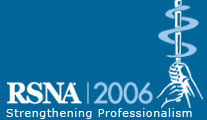
Abstract Archives of the RSNA, 2006
SSC08-03
Diagnostic Accuracy of Dual-Source Computed Tomography in the Diagnosis of Ischemic Heart Disease: Initial Experience
Scientific Papers
Presented on November 27, 2006
Presented as part of SSC08: ISP: Cardiac (CT)
Konstantin Nikolaou MD, Presenter: Nothing to Disclose
Thorsten Ralph Christopher Johnson MD, Abstract Co-Author: Nothing to Disclose
Bernd Juergen Wintersperger MD, Abstract Co-Author: Nothing to Disclose
Andreas Knez MD, Abstract Co-Author: Nothing to Disclose
Maximilian Ferdinand Reiser MD, Abstract Co-Author: Nothing to Disclose
Christoph Becker MD, Abstract Co-Author: Nothing to Disclose
The aim of this study was to evaluate the potential clinical value of a new generation of Dual-Source Computed Tomography (DSCT) systems with that of invasive coronary angiography in the diagnosis of coronary artery disease (CAD).
In an ongoing study, 16 consecutive patients with known or suspected CAD underwent both DSCT and quantitative X-ray coronary angiography (QCA) by now. A CT system with two rotating gantries and acquisition of 64 slices per gantry rotation was employed (Somatom Definition, Siemens Medical Solutions), with a spatial resolution of 0.4x0.4x0.4 mm, a gantry rotation time of 330ms, and a temporal resolution of 83ms. The volume anf flow rate of contrast medium injection (Ultravist 370, Schering AG) was adapted to the patient’s body weight. Sensitivity, specificity, positive predictive value (PPV) and negative predictive value (NPV) of DSCT in the detection or exclusion of significant CAD (i.e., stenoses >50%) were evaluated on a per-patient and per-segment basis.
On a per patient basis, all 16 CT angiograms were of diagnostic image quality. QCA demonstrated significant CAD in 62% (10/16) and non-significant disease or normal coronary angiograms in 38% (6/16) of the patients. Sensitivity, specificity, PPV and NPV of DSCT on a per-patient basis were 100% (10/10), 83% (5/6), 91% (10/11), and 100% (5/5), respectively. On a per segment basis, 231 of 240 coronary artery segments were assessable (96%). QCA demonstrated stenoses >50% in 22 segments (9%), and no disease or non-significant disease in 218 segments (91%). For the detection of stenoses >50% on a per-segment basis, DSCT showed a sensitivity, specificity, PPV and NPV of 95%, 98%, 82%, and 99%, respectively.
In this ongoing study, initial results comparing coronary DSCT with QCA showed a very robust image quality and a high diagnostic accuracy on a per-patient based as well as on a per-segment based analysis.
The increased temporal resolution of a dual-source CT system offers a robust image quality for coronary artery imaging, providing a high diagnostic accuracy in the diagnosis of coronary artery disease
Nikolaou, K,
Johnson, T,
Wintersperger, B,
Knez, A,
Reiser, M,
Becker, C,
Diagnostic Accuracy of Dual-Source Computed Tomography in the Diagnosis of Ischemic Heart Disease: Initial Experience. Radiological Society of North America 2006 Scientific Assembly and Annual Meeting, November 26 - December 1, 2006 ,Chicago IL.
http://archive.rsna.org/2006/4435831.html

